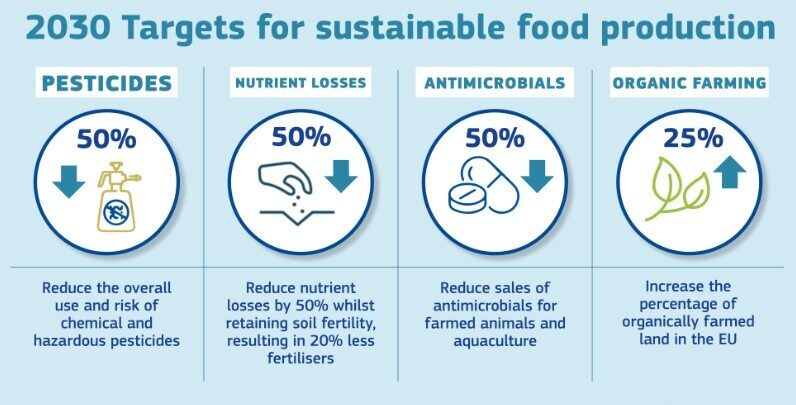
Both the Biodiversity Strategy for 2030 and the Farm to Fork Strategy (F2F) indirectly address threats to soil biodiversity. Both strategies aim to reduce:
- Fertilisers by 20%.
- Nutrient losses by at least 50%.
- Overall use and risk of chemical pesticide use by 50% and hazardous pesticides by a further 50%.
- And increase organic farms to 25% by 2030.
This would avoid soil contamination and, on the other hand, enhance the use of organic fertilisers and thus protect the soil, as we have seen in a previous entry.
The F2F strategy proposes a revision of the Sustainable Use of Pesticides Directive to significantly reduce the use, risk and dependence on pesticides and to enhance integrated pest management. The Biodiversity Strategy explicitly addresses land degradation and soil restoration: protected areas +30% and planting more than 3 billion trees by 2030. In addition, increased application of agro-ecological practices and reduced deforestation to mitigate climate change is encouraged. This, in turn, will benefit soil biodiversity.
One of the key measures announced by the Biodiversity Strategy 2030 are regulatory targets for nature restoration. The EC proposed targets during 2022, including several soil protection measures that indirectly protect soil biodiversity. The F2F Strategy also announced a proposal for a legislative framework for a sustainable EU food system, due in 2023.
Although the Biodiversity Strategy 2030 included the objective of protecting soil ecosystems, there is still no uniform definition of soil biodiversity protection at EU level.
Furthermore, the Biodiversity Strategy 2030 does not yet address the risks associated with soil compaction and conventional tillage. The F2F Strategy does not explicitly consider soil compaction, tillage, soil organic matter loss, soil erosion, soil sealing and habitat fragmentation, but it does call for a more sustainable EU food system.
On the other hand, some of the proposed actions could have conflicting effects. For example, for more sustainable manure management, both the F2F Strategy and the Circular Economy Plan see anaerobic digestion as a solution to reduce greenhouse gas emissions, but this does not integrate the negative effects of carbon availability and heavy metal/antibiotic content on soil biodiversity.
You can find more information in this article, “In defence of biodiversity: towards an inclusive protection in the Europe Union“.

Estrategias F2F y biodiversidad 2030 en la protección del suelo
Tanto la Estrategia de Biodiversidad para 2030 como la Estrategia “de la granja a la mesa” (F2F) abordan indirectamente las amenazas a la biodiversidad del suelo. Ambas estrategias pretenden reducir:
- Los fertilizantes en un 20%.
- Las pérdidas de nutrientes en al menos un 50%.
- El uso global y el riesgo del uso de plaguicidas químicos en un 50% y los plaguicidas peligrosos en un 50% adicional.
- Y aumentar las explotaciones ecológicas al 25% para 2030
De esta forma se evitaría la contaminación del suelo y, por otro lado, potenciar el uso de fertilizantes orgánicos y, por tanto, proteger el suelo, como hemos visto en una entra anterior.
La estrategia F2F propone una revisión de la Directiva sobre Uso Sostenible de Plaguicidas para reducir significativamente el uso, el riesgo y la dependencia de los plaguicidas y potenciar la gestión integrada de plagas. Por su lado, la Estrategia de Biodiversidad aborda explícitamente la degradación de la tierra y la restauración del suelo: áreas protegidas +30% y plantar más de 3.000 millones de árboles para 2030. Además, se fomenta el aumento de la aplicación de prácticas agroecológicas y la reducción de la deforestación para mitigar el cambio climático. Esto, a su vez, beneficiará a la biodiversidad del suelo.
Una de las medidas clave anunciadas por la Estrategia de Biodiversidad 2030 son los objetivos reglamentarios de restauración de la naturaleza. La Comisión Europea propuso los objetivos durante 2022, incluidas varias medidas de protección del suelo que protegen indirectamente la biodiversidad del suelo. Asimismo, la Estrategia F2F anunció una propuesta de marco legislativo para un sistema alimentario sostenible de la UE, prevista para 2023.
Aunque la Estrategia de Biodiversidad para 2030 incluía el objetivo de proteger los ecosistemas del suelo, aún no existe una definición uniforme de protección de la biodiversidad del suelo a escala de la UE.
Además, la Estrategia de Biodiversidad para 2030 todavía no aborda los riesgos asociados a la compactación del suelo y al laboreo convencional. La Estrategia F2F no considera explícitamente la compactación del suelo, el laboreo, la pérdida de materia orgánica del suelo, la erosión del suelo, el sellado y la fragmentación del hábitat, pero sí aboga por un sistema alimentario de la UE más sostenible.
Por otro lado, algunas de las acciones propuestas podrían tener efectos contrapuestos. Por ejemplo, para una gestión más sostenible del estiércol, tanto la Estrategia F2F como el Plan de Economía Circular ven la digestión anaerobia como una solución para reducir las emisiones de gases de efecto invernadero, pero esto no integra los efectos negativos de la disponibilidad de carbono y el contenido de metales pesados/antibióticos en la biodiversidad del suelo.
Podéis encontrar más información en este artículo, “In defence of biodiversity: towards an inclusive protection in the Europe Union“.


